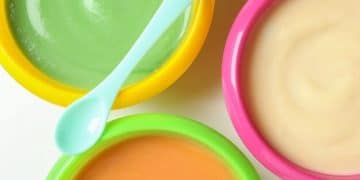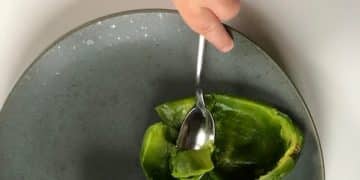Iron-Rich Foods for Babies: Top 5 Choices to Prevent Deficiency
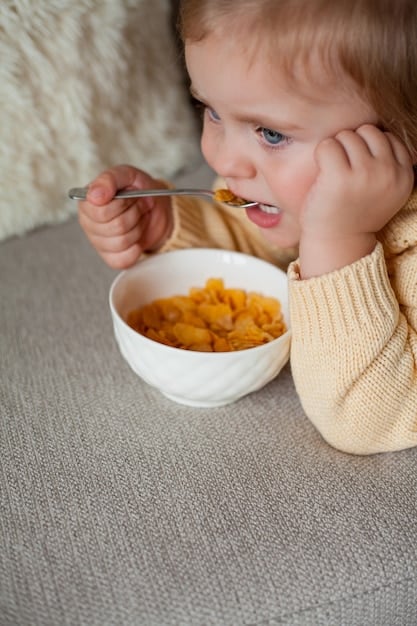
Iron-rich foods are crucial for babies to prevent iron deficiency, which can impact their development; incorporating fortified cereals, pureed meats, beans, spinach, and egg yolks into a baby’s diet can help ensure they receive enough iron.
Ensuring your baby gets enough iron can be a concern for many parents. Discover the top 5 iron-rich foods for babies: preventing deficiency with these top 5 choices is easier than you think with the right knowledge and food options.
Understanding Iron Deficiency in Babies
Iron deficiency is a common issue among babies, particularly those between 6 months and 2 years old. This is because iron stores acquired during pregnancy start to deplete, and breast milk alone may not provide enough iron to meet their growing needs.
Why Iron Matters for Babies
Iron is essential for a baby’s growth and development. It plays a crucial role in carrying oxygen throughout the body and supports healthy brain development.
Consequences of Iron Deficiency
Iron deficiency can lead to several health problems in babies, including anemia, delayed cognitive and motor development, and weakened immune system.
- 💪 Impaired Brain Development: Ensuring sufficient iron intake supports optimal cognitive function.
- 😢 Anemia Prevention: Adequate iron levels are crucial to prevent anemia.
- 🛡️ Stronger Immune System: Iron supports a healthy immune response, reducing the risk of infections.
- 🌱 Healthy Growth: Iron is vital for overall physical growth and development.
Recognizing the importance of iron and understanding its role in your baby’s health is the first step in preventing iron deficiency. Ensuring your baby has a balanced diet rich in iron-rich foods is essential for their overall well-being.
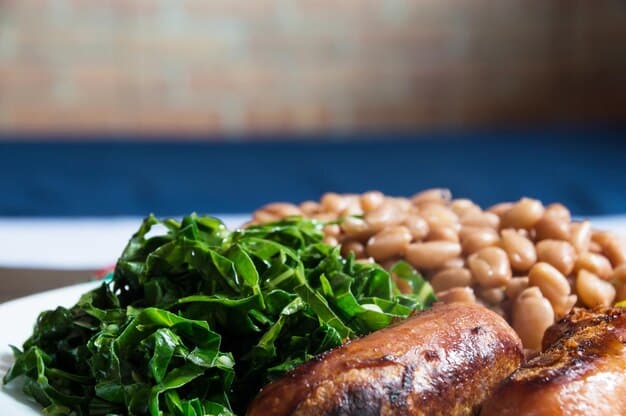
Top 5 Iron-Rich Foods for Babies
Introducing iron-rich foods into your baby’s diet is a crucial step in preventing iron deficiency. Here are five excellent choices that are easy to prepare and can be readily incorporated into meals.
1. Iron-Fortified Cereals
Iron-fortified cereals are often the first food recommended for babies. These cereals are specifically designed to provide a significant amount of iron in an easily digestible form.
How to Incorporate Cereal
Start with single-grain cereals like rice, oat, or barley, and mix them with breast milk or formula to create a smooth, easy-to-swallow texture. Introduce the foods slowly.
2. Pureed Meats
Meat, especially red meat, is an excellent source of heme iron, which is more easily absorbed by the body compared to non-heme iron found in plant-based foods. Meats such as beef and chicken are good options.
- 🥩 Easier Absorption: Heme iron in meat is more readily absorbed.
- 👶 Early Introduction: Introducing meats early can help babies meet their iron needs.
- 🥣 Versatile Preparation: Pureed meats can be mixed with vegetables for balanced meals.
3. Beans and Lentils
Beans and lentils are plant-based powerhouses of iron, offering a vegetarian-friendly alternative to meat. They are also packed with fiber and other nutrients.
Preparing Beans and Lentils
To make them suitable for babies, cook them thoroughly and puree them until smooth. These can be mixed with other vegetables or grains to create a balanced meal.
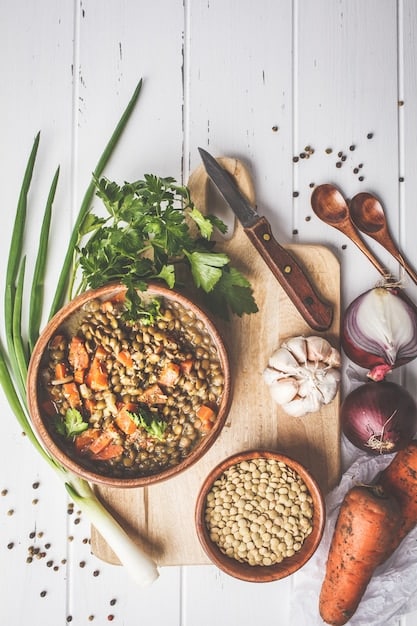
4. Spinach and Dark Leafy Greens
Spinach and other dark leafy greens like kale and collard greens are good sources of non-heme iron. While not as easily absorbed as heme iron, they still contribute to a baby’s iron intake.
Serving Spinach and Greens
Steam or cook the greens until tender and puree them to a smooth consistency. Mixing them with vitamin C-rich foods like tomatoes can enhance iron absorption.
5. Egg Yolks
Egg yolks are a good source of iron and other essential nutrients. However, it’s important to introduce eggs carefully due to potential allergies.
- 🥚 Essential Nutrients: Egg yolks contain not only iron but also other vital nutrients for growth.
- ⚠️ Allergy Caution: Introduce eggs carefully to monitor for any allergic reactions.
- 🥄 Easy to Mix: Cooked and mashed egg yolks can be mixed with other pureed foods.
Introducing these top 5 iron-rich foods into your baby’s diet not only helps prevent iron deficiency but also encourages a diverse and nutritious eating pattern from an early age.
Tips for Maximizing Iron Absorption
While feeding your baby iron-rich foods is crucial, maximizing the absorption of iron from these foods is equally important. There are several strategies you can employ to enhance iron uptake from the foods you provide.
Combine Iron-Rich Foods with Vitamin C
Vitamin C significantly enhances the absorption of non-heme iron, which is found in plant-based foods like spinach and beans. Combining these foods with sources of vitamin C can make a big difference.
Examples of Vitamin C-Rich Foods
Good choices include tomatoes, bell peppers, broccoli, strawberries, and citrus fruits. For example, mixing pureed spinach with a small amount of pureed tomatoes can boost iron absorption.
Avoid Giving Iron-Rich Foods with Dairy Products
Dairy products contain calcium, which can inhibit iron absorption. It’s best to avoid giving iron-rich foods at the same time as dairy.
Timing is Key
Try to offer iron-rich foods at different times than when you give your baby milk or other dairy products. Spacing out these feedings can help optimize iron absorption.
Cook in Cast Iron
Cooking foods, especially acidic ones like tomato sauce, in a cast iron skillet can increase the iron content of the food. The iron from the skillet leaches into the food, providing an extra boost of iron.
- 🍳 Iron Leaching: Cooking in cast iron can naturally fortify foods with iron.
- 🍅 Acidic Foods: Acidic foods like tomato sauce absorb more iron from the cookware.
- 🌱 Increased Intake: This method subtly increases iron intake without changing the diet.
By implementing these simple strategies, you can significantly improve your baby’s iron absorption, ensuring they receive the maximum benefit from the iron-rich foods you provide.
Recognizing Iron Deficiency Symptoms
Being able to recognize the symptoms of iron deficiency is essential for early intervention. If you suspect your baby might be iron deficient, consult with your pediatrician for a proper diagnosis and treatment plan.
Common Symptoms of Iron Deficiency
Symptoms of iron deficiency can vary but often include pale skin, fatigue, irritability, poor appetite, and developmental delays.
Pale Skin
One of the most noticeable signs of iron deficiency is pale skin, especially in the face, gums, and inner eyelids.
Fatigue and Irritability
Babies who are iron deficient may seem unusually tired or irritable, even after adequate rest.
Poor Appetite
A decreased interest in eating or refusing foods that they previously enjoyed can also be a sign of iron deficiency.
Developmental Delays
In more severe cases, iron deficiency can lead to delays in cognitive and motor development.
- 😴 Persistent Fatigue: Consistent tiredness despite sufficient rest.
- 😟 Irritability: Increased fussiness and difficulty in calming the baby.
- 📉 Slow Growth: Failure to meet expected developmental milestones.
- 👅 Changes in Appetite: Unusual cravings for non-food items like dirt or ice (pica).
If you notice any of these symptoms in your baby, it’s crucial to seek medical advice promptly. Early detection and treatment can help prevent long-term health problems associated with iron deficiency.
How to Introduce Iron-Rich Foods Safely
Introducing new foods to your baby requires patience and careful observation to ensure they are well-tolerated. Here are some guidelines to help you introduce iron-rich foods safely.
The Four-Day Wait Rule
When introducing new foods, follow the four-day wait rule. Introduce one new food at a time and wait four days before introducing another. This allows you to monitor your baby for any allergic reactions or digestive issues.
Start with Small Portions
Begin with small portions, such as one or two teaspoons of the new food. Gradually increase the portion size as your baby tolerates the food well.
Monitor for Allergic Reactions
Watch for signs of allergic reactions, such as rashes, hives, vomiting, diarrhea, or difficulty breathing. If you notice any of these symptoms, stop feeding the food and consult with your pediatrician.
Pay Attention to Texture
Ensure the food is appropriately pureed or mashed to a smooth consistency to prevent choking hazards. As your baby grows older, you can gradually introduce thicker textures.
Consistency is Key
Offer iron-rich foods consistently as part of a balanced diet. Regular exposure helps your baby get used to new flavors and textures, making it easier to establish healthy eating habits.
- 👶 New Foods: Introduce one new food at a time to easily identify allergies.
- 🥄 Serving Size: Start with small portions to gauge tolerance.
- 🩺 Early Intervention: Consult a pediatrician for any allergic reactions.
- 🌱 Introduce consistently: Introduce iron-rich foods consistently.
By following these guidelines, you can safely introduce iron-rich foods into your baby’s diet, ensuring they receive the nutrients they need for healthy growth and development.
Consulting with a Pediatrician or Nutritionist
Seeking guidance from a pediatrician or nutritionist can be invaluable in addressing your baby’s iron needs. These healthcare professionals can provide personalized advice based on your baby’s individual health profile.
When to Seek Professional Advice
If you have concerns about your baby’s iron intake, notice signs of iron deficiency, or if your baby has specific dietary restrictions, consulting with a healthcare professional is highly recommended.
Benefits of Consulting a Pediatrician
A pediatrician can assess your baby’s overall health and determine if they are at risk for iron deficiency. They can also order blood tests to check iron levels and recommend appropriate interventions.
Role of a Nutritionist
A nutritionist specializing in pediatric nutrition can help you develop a balanced meal plan that meets your baby’s iron requirements. They can also offer tips on preparing iron-rich foods in a way that maximizes nutrient absorption.
- 🩺 Regular Check-ups: Scheduled visits with a pediatrician ensure timely monitoring of your baby’s health.
- 🩸 Blood Tests: Diagnostic tests can accurately determine iron levels and detect deficiencies early.
- 🍽️ Personalized Meal Plans: A nutritionist can tailor a diet to meet specific needs and optimize nutrient intake.
By working with healthcare professionals, you can gain valuable insights and support in ensuring your baby receives adequate iron for healthy growth and development. This collaborative approach can provide peace of mind knowing that you are taking the best possible care of your baby’s nutritional needs.
| Key Point | Brief Description |
|---|---|
| 💪 Iron-Rich Foods | Include fortified cereals, pureed meats, beans, spinach, and egg yolks. |
| 🍊 Vitamin C | Enhances iron absorption when combined with iron-rich foods. |
| 🥛 Avoid Dairy | Dairy products can inhibit iron absorption, so avoid giving them together. |
| 🩺 Consult Professionals | Consult with a pediatrician or nutritionist for personalized advice and care. |
Frequently Asked Questions
▼
Iron is crucial for a baby’s growth and development, supporting oxygen transport and healthy brain development. Deficiencies can lead to anemia and developmental delays.
▼
Around 6 months of age, babies start needing additional iron sources. This is a good time to introduce iron-fortified cereals and pureed meats into their diet.
▼
Watch for signs like pale skin, fatigue, and irritability. A pediatrician can perform a blood test to check your baby’s iron levels and determine if supplementation is needed.
▼
Breast milk is highly nutritious, but it may not provide enough iron after 6 months. Supplementing with iron-rich foods is essential to meet their increasing iron needs.
▼
Excellent vegetarian sources of iron include beans, lentils, spinach, and iron-fortified cereals. Pairing these with vitamin C-rich foods enhances iron absorption for optimal health.
Conclusion
Ensuring your baby gets enough iron is vital for their healthy development. By incorporating these top 5 iron-rich foods into their diet and maximizing iron absorption, you can help prevent iron deficiency and support their overall well-being. Don’t hesitate to consult with healthcare professionals for personalized advice and guidance.




